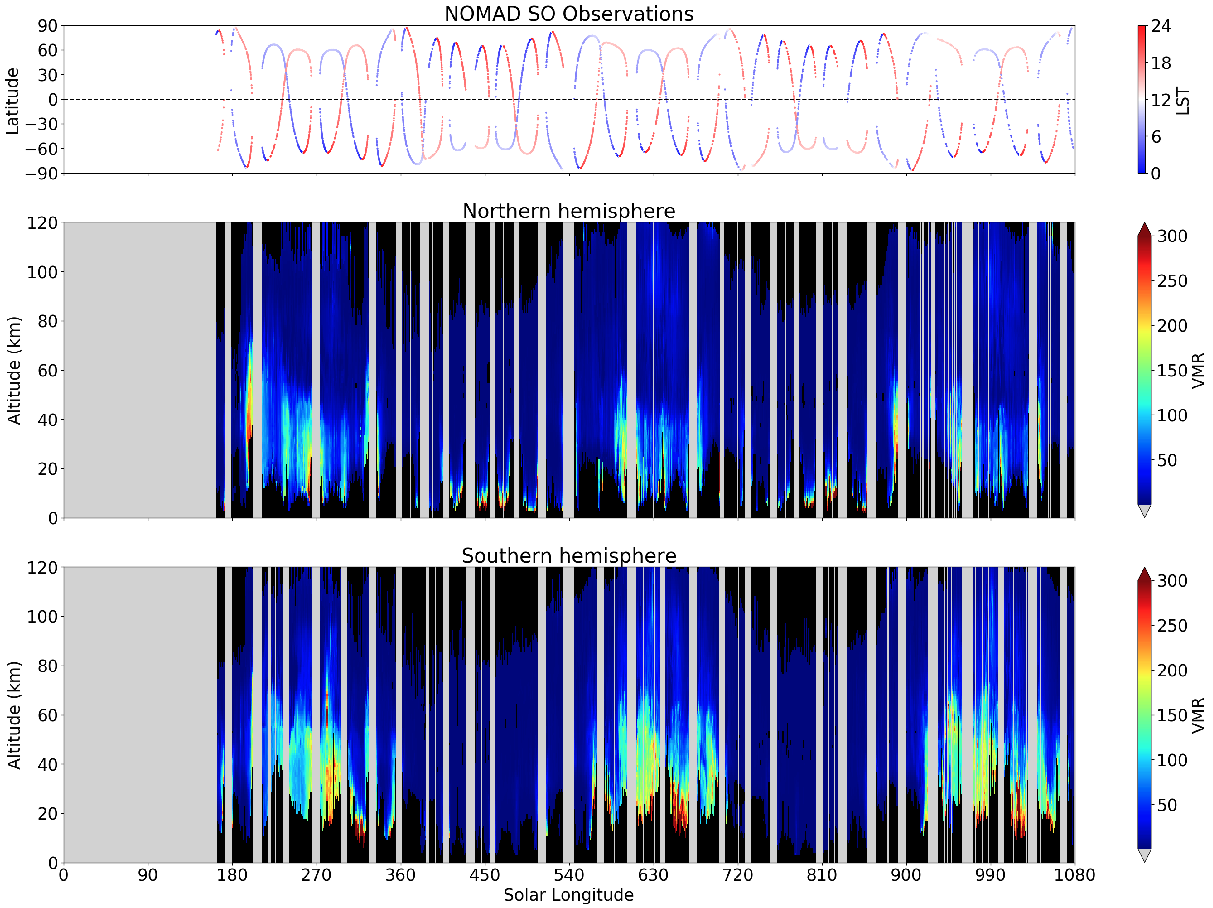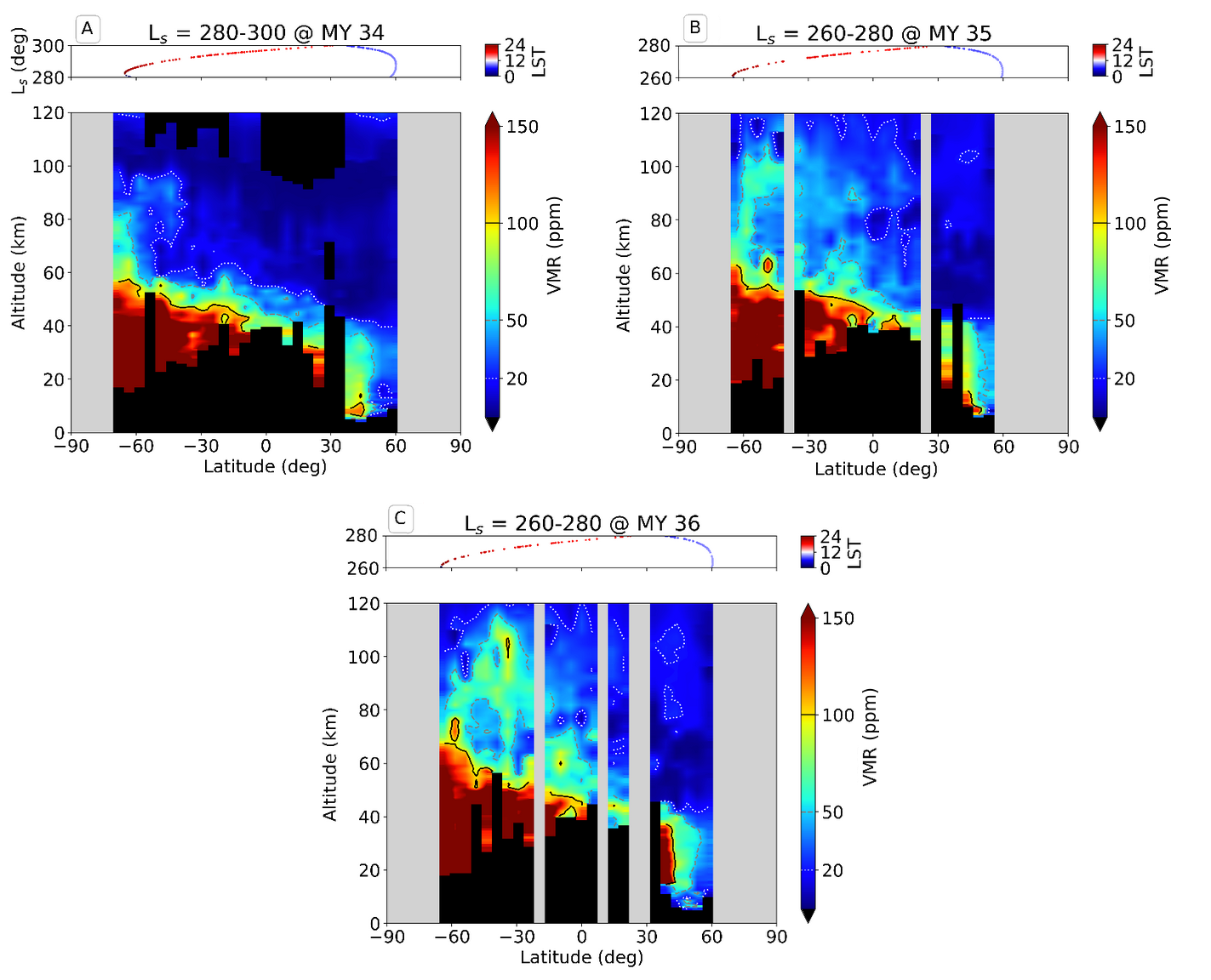- 1Instituto de Astrofísica de Andalucía (IAA), Grupo de Atmósferas Planetarias Terrestres (GAPT), Spain (adrianbm@iaa.es)
- 2Royal Belgian Institute for Space Aeronomy, Belgium
- 3Department of Complexity Science and Engineering, Graduate School of Frontier Sciences, The University of Tokyo, Kashiwa, Japan
- 4NASA Goddard Space Flight Center, USA
- 5University of Basilicata, Italy
- 6Open University, UK
- 7Istituto di Astrofisica e Planetologia, Italy
NOMAD [1] (Nadir and Occultation for MArs Discovery) is a multi-channel spectrometer onboard the ExoMars 2016 Trace Gas Orbiter (TGO), which began its observations in April 2018. Among other two (LNO and UVIS), the Solar Occultation (SO) channel covers the infrared (IR) spectrum from 2.3 to 4.3 µm (2320 to 4350 cm-1). Composed of an echelle grating in Litrow configuration, a total of 6 diffraction orders (with a typical width from 20 to 35 cm-1) are selected during each solar occultation using an Acousto-Optical Tunable Filter (AOTF) with a sample rate of about ~1 s, allowing a vertical resolution of typically 1 km. In order to optimize the information content that can be retrieved from the data, we analyzed Level 1 calibrated transmittances [2, 3] from four diffraction orders: 134 (3011-3035 cm−1), 136 (3056-3081 cm−1), 168 (3775-3805 cm−1) and 169 (3798-3828 cm−1). At the IAA-CSIC we developed processing tools specifically designed to handle and remove some systematics present in the NOMAD data, such as spectral shift and bending on the baseline of the spectra [4]. In addition, we performed an in-house characterization of the measurement noise using covariance matrices, identifying the true random component of the noise. This improvement allowed us to obtain homogeneous vertical profiles from the surface to an altitude about ~120 km. The profiles shown here have been retrieved combining two diffraction orders, this is, performing a global fit using spectra from two orders simultaneously. We combined pairs of orders 134 or 136 with 168 or 169 using them at different altitude ranges. The first two contain relatively weak absorption lines (S~10−21 cm−1/(molecule·cm−2) allowing the sample of the low atmosphere. On the contrary, the second set of orders contain strong lines close to center of the ν3 band(S~10−19 cm−1/(molecule·cm−2) which are useful to sample the upper atmosphere. This methodology is possible only when both orders have been measured during the same solar occultation, and although it limits the number of occultations available, it is necessary in order to avoid optically thick lines. Typically, we used low altitude orders (134/136) below 60 km and high altitude orders (168/169) above 60 km.
The content presented here is a follow-up work building upon several previous studies [5–8]. We extended the dataset selecting a total of 6561 occultations taken during Martian Years (MY) 34,35 and 36. We discuss detailed seasonal and latitudinal maps, showing the vertical distribution of the water vapor abundance and its variability thought the year. A summary of this work can be seen in Fig. 1, where we show the seasonal variation of all the retrieved water vapor profiles.

Figure 1: Vertical distribution of water vapor during MYs 34, 35 and 36 for the Northern (middle panel) and Southern (bottom panel) hemispheres. Horizontal axis shows the Solar longitude. Top panel indicates the latitude and local time of the observations.
Figure 1 clearly shows a repeated pattern in both hemispheres. Water vapor is present in a more vertically extended range during the Southern summer (perihelion season) whereas it is mostly confined to low altitudes (below 20 km) during the aphelion season, which corresponds to the Northern summer. Also, the characteristic Global Dust Storm (GDS) that took place in 2018 can be seen at the beginning of the MY 34 (LS~190º), showing a distinctive peak in water abundance in the northern hemisphere that is not repeated again.
In addition, we analyzed in detail the latitudinal distribution of water vapor during the perihelion season. We noticed a strong vertical plume at 60ºS - 50ºS injecting H2O into the mesosphere, reaching abundances of about ~50 ppmv at 100 km. We observed this event repeatedly in the three Martian years analyzed, although with inter-annual variations in both its magnitude and timing. The plume showed a weaker structure with less abundance during MY 34. We suggest that this difference respect to MYs 35 and 36 could possibly due to indirect effects of the MY 34 GDS. A summary of this analysis is presented in Fig. 2 where a storng water vapor injection can be seen in MYs 35 and 36 (panels B and C respectively).

Figure 2: Water vapor latitudinal variation during LS = 260º-280º for MYs 34, 35 and 36 (panels A, B and C respectively). Dots in top panels indicate latitude, Solar Longitude and Local Solar Time of the observations.
Acknowledgments
The IAA/CSIC team acknowledges financial support from the Severo Ochoa grant CEX2021-001131-S and by grants PID2022-137579NB-I00,RTI2018-100920-J-I00 and PID2022-141216NB-I00 all funded by MCIN/AEI/ 10.13039/501100011033. A. Brines acknowledges financial support from PRE2019-088355 funded by MCIN/AEI/10.13039/501100011033. ExoMars is a space mission of the European Space Agency (ESA) and Roscosmos. The NOMAD experiment is led by the Royal Belgian Institute for Space Aeronomy (IASB-BIRA), assisted by Co-PI teams from Spain (IAA-CSIC), Italy (INAF-IAPS), and the United Kingdom (Open University). This project acknowledges funding by the Belgian Science Policy Office (BELSPO), with the financial and contractual coordination by the ESA Prodex Office (PEA 4000103401, 4000121493), by Spanish Ministry of Science and Innovation (MCIU) and by European funds under grants PGC2018-101836-B-I00 and ESP2017-87143-R (MINECO/FEDER), as well as by UK Space Agency through grants ST/V002295/1, ST/V005332/1, ST/Y000234/1 and ST/X006549/1 and Italian Space Agency through grant 2018-2-HH.0. This project has received funding from the European Union’s Horizon 2020 grant No 101004052. US investigators were supported by the NASA. Canadian investigators were supported by the Canadian Space Agency. We want to thank M. Vals, F. Montmessin, F. Lefevre, F. Forget and the broad LMD/IPSL team supporting the Mars PCM.
References
1. Vandaele, A. C. (2018). Space Science Reviews, 214.
2. Thomas, I. R. (2022). Planetary and Space Science, 218.
3. Trompet, L. (2023). Journal of Geophysical Research: Planets, 128(3).
4. López-Valverde, M. A. (2023). Journal of Geophysical Research: Planets, 128(2).
5. Brines, A. (2023). Journal of Geophysical Research: Planets, 128(11).
6. Aoki, S. (2019). Journal of Geophysical Research: Planets, 124(12).
7. Aoki, S. (2022). Journal of Geophysical Research: Planets, 127(9).
8. Villanueva, G. L. (2022). Geophysical Research Letters, 49(12).
How to cite: Brines, A., Lopez-Valverde, M. A., Stolzenbach, A., Modak, A., Funke, B., González-Galindo, F., López-Moreno, J. J., Sanz-Mesa, R., Aoki, S., Vandaele, A. C., Daerden, F., Thomas, I., Erwin, J., Trompet, L., Ristic, B., Villanueva, G., Liuzzi, G., Patel, M., and Bellucci, G.: Global Vertical Distribution of Water Vapor in the Martian Atmosphere for 6 years of ExoMars-TGO/NOMAD observations, Europlanet Science Congress 2024, Berlin, Germany, 8–13 Sep 2024, EPSC2024-1018, https://doi.org/10.5194/epsc2024-1018, 2024.